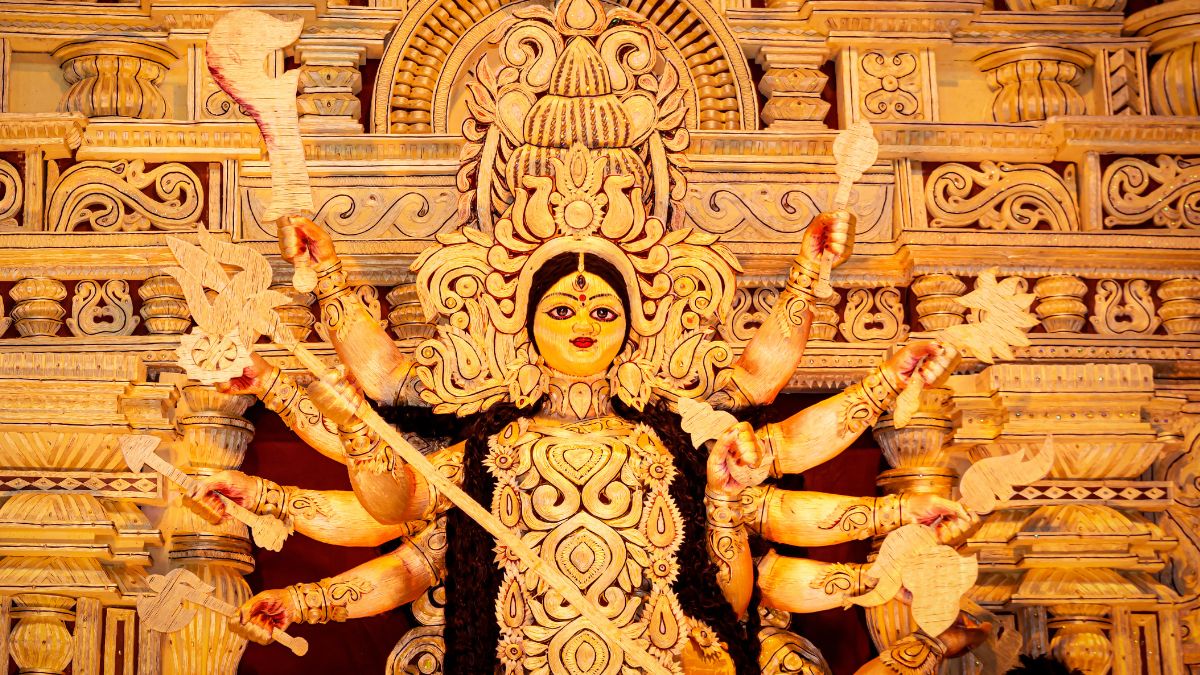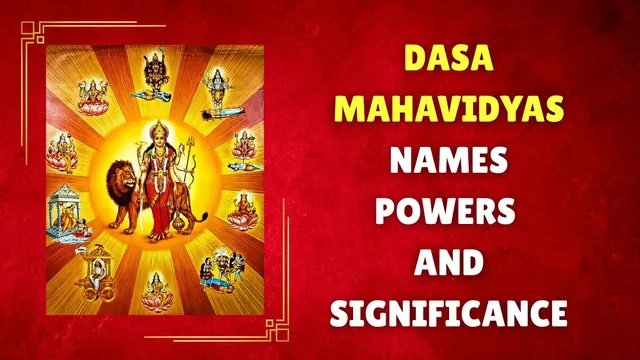- By Kashish Rai
- Wed, 25 Jun 2025 10:00 AM (IST)
- Source:JND
Ashadha Gupt Navratri 2025 holds deep spiritual importance in Hinduism, especially for seekers following the tantric path. Unlike the widely known Navratris, this one is observed quietly, focusing on inner transformation and discipline. During this period, the ten Mahavidyas are worshipped with devotion. Each goddess represents a unique aspect of the Divine Feminine, guiding the devotee through different stages of spiritual growth. Gupt Navratri is believed to awaken hidden energies, destroy obstacles and grant powerful spiritual insights. This year, Ashadha Gupt Navratri begins on 26th June 2025.
Find all the relevant details regarding the names, powers and significance of the 10 Mahavidyas worshipped during this significant period below:
Ashadha Gupt Navratri 2025: Names, Powers And Significance Of 10 Mahavidyas Worshipped During These 9 Days
Maa Kali
Maa Kali, the first Mahavidya, symbolises time, transformation, and the fierce aspect of the Divine Mother. She is dark, powerful, and fearless—known for destroying ego, ignorance, and negativity. With her sword and garland of skulls, she reminds us that endings often lead to new beginnings. Worshipping Kali during Gupt Navratri helps one conquer inner fears, detach from material illusions, and move closer to spiritual truth. Despite her fearsome form, she is deeply compassionate, protecting her devotees from harm. Her energy is intense but purifying, ideal for those seeking deep change, spiritual growth, and the courage to face life head-on.
Maa Tara
Maa Tara is the guiding star, the rescuer who pulls her devotees out of emotional storms and dark times. She is a nurturing yet powerful form of Shakti, known for her maternal care and ability to remove suffering. Tara’s energy provides spiritual clarity, mental peace, and direction when life feels uncertain. In Gupt Navratri, seekers invoke her for protection, especially in moments of doubt or despair. She governs speech, wisdom, and guidance, making her a perfect ally for students, meditators, and spiritual aspirants. Her compassionate nature makes her approachable, while her strength gives reassurance to those walking uncertain paths.
Maa Tripura Sundari
Maa Tripura Sundari, also called Shodashi, is the goddess of beauty, grace, and harmony. She embodies perfection and the blissful union of body, mind, and soul. Worshipped during Gupt Navratri, she helps align one’s inner world with outer beauty and prosperity. Her presence is soft yet commanding—she draws the soul towards peace and higher love. She’s believed to bless relationships, abundance, and creative energy. Her devotees seek her to gain charm, wisdom, and a life filled with balance. Above all, she reminds us that spiritual beauty and divine radiance lie within us when we live in harmony with truth.
Maa Bhuvaneshwari
Maa Bhuvaneshwari is the sovereign queen of the universe, embodying cosmic space and motherly compassion. She holds the entire creation within her vast form and blesses her devotees with expansion, confidence, and abundance. During Ashadha Gupt Navratri, sadhakas meditate upon her to realise their limitless nature. Her energy is nurturing and boundless, often sought by those wishing to grow spiritually and materially. She governs the element of space and gives one the grace to hold, accept, and transform life’s experiences. Bhuvaneshwari helps create a life of fullness and guides us gently to recognise the divine presence all around us.
ALSO READ: 5 Astonishing Facts About The Menstruating Goddess Kamakhya Devi You Did Not Know

10 Mahavidyas are the 10 fierce forms of Adi Parashakti, fervently worshipped by the tantric sadhakas during Gupt Navratri. (Image Source: Canva)
Maa Bhairavi
Maa Bhairavi is the fierce and radiant goddess of discipline, focus, and fearlessness. She represents spiritual intensity and is often called the warrior form of the Divine Mother. During Gupt Navratri, those walking the path of sadhana seek her blessings to overcome inner and outer obstacles. She helps burn away negativity, laziness, and distraction, allowing true transformation to unfold. Though intense, her love is protective, like a mother pushing her child to become stronger. Bhairavi empowers her devotees with boldness, spiritual discipline, and strength to face trials. She teaches that growth sometimes comes from fire, not just comfort.
Maa Chinnamasta
Maa Chinnamasta is one of the most symbolic and thought-provoking Mahavidyas. She’s depicted holding her severed head, which drinks her own blood, representing self-sacrifice and spiritual awakening. Though her image is fierce, it teaches a deep lesson—that true liberation comes when we surrender our ego and selfish desires. Her worship during Gupt Navratri is for those ready to walk a path of deep inner change. She grants clarity, detachment, and a fearless heart. Her energy is transformative, reminding us that letting go is often the first step to receiving something greater. She awakens awareness and the power to transcend limitations.
Maa Dhumavati
Maa Dhumavati represents the void, sorrow, and the wisdom that comes from experiencing life’s hardships. Often depicted as an old widow riding a chariot without adornments, she symbolises detachment and the transient nature of the material world. Her worship is usually avoided by married individuals, as she carries the energy of solitude and renunciation. During Gupt Navratri, her devotees are typically spiritual seekers or sadhus seeking deeper truths. She blesses one with discernment, patience, and the ability to see beyond illusions. Her presence is subtle but powerful—she teaches that silence, stillness, and introspection are doorways to divine understanding.
Maa Bagalamukhi
Maa Bagalamukhi is the goddess of power, silence, and victory. She has the unique ability to stop or paralyse enemies, both within and outside. Her energy is often called upon during legal battles, conflicts, or situations where one feels under attack. During Gupt Navratri, she is worshipped to gain control over negative thoughts, speech, and harmful influences. Her golden form radiates confidence and quiet authority. While she is protective, her real gift lies in giving her devotees inner silence—the power to speak wisely, act mindfully, and stand firmly in truth. She is strength rooted in stillness and divine command.
Maa Matangi
Maa Matangi is the goddess of music, speech, learning, and creative expression. She governs the power of words and the arts, making her the perfect guide for artists, thinkers, and teachers. During Gupt Navratri, her devotees seek eloquence, knowledge, and clarity in communication. She is also known as the Tantric Saraswati, holding wisdom that goes beyond books and into the intuitive heart. Matangi blesses those who wish to purify their speech and align their voice with divine purpose. Her energy invites expression that is truthful, powerful, and transformative. She teaches that sound itself can become a path to liberation.
Maa Kamala
Maa Kamala is the radiant goddess of wealth, fertility, and divine grace. Closely associated with Lakshmi, she governs prosperity but with a spiritual depth that goes beyond material riches. Worshipping Kamala during Gupt Navratri brings abundance, harmony in home life, and a strong sense of contentment. She blesses her devotees with generosity, beauty, and a steady, nurturing energy. Kamala also represents the blooming of one’s spiritual potential amidst worldly life. She shows that true prosperity includes inner peace, kindness and gratitude. Her presence is warm and inviting, reminding us that with devotion and virtue, blessings naturally flow into our lives.

